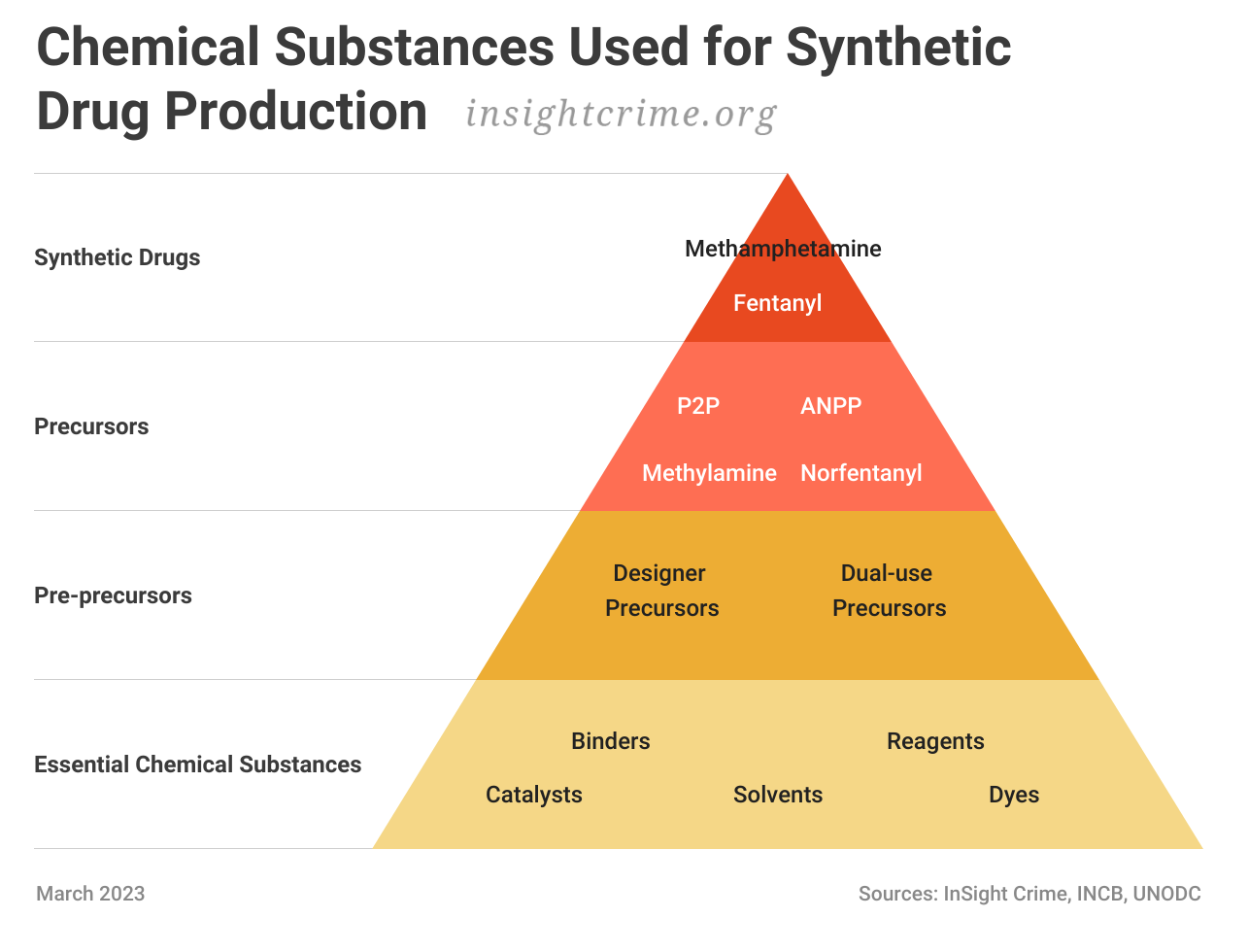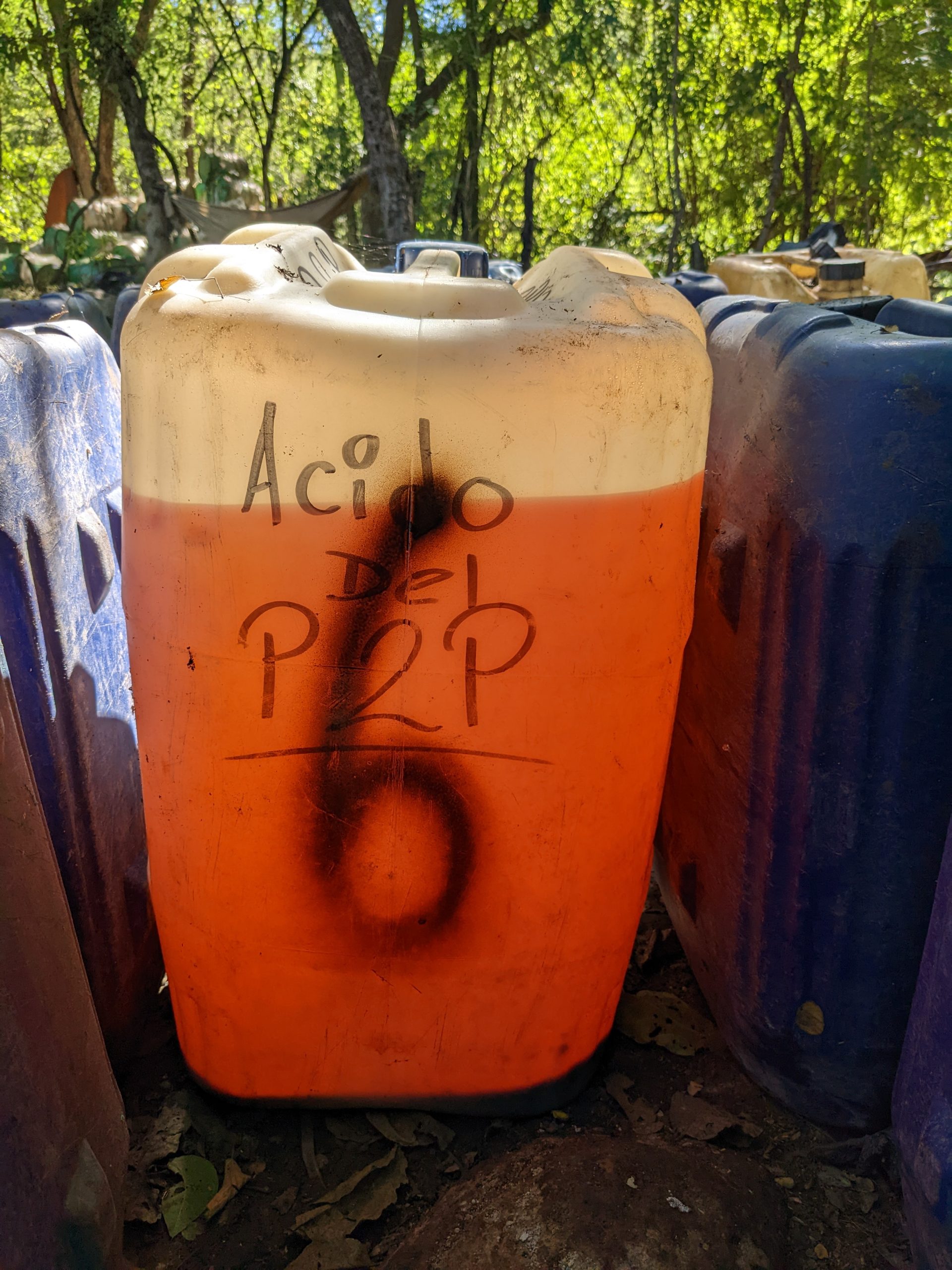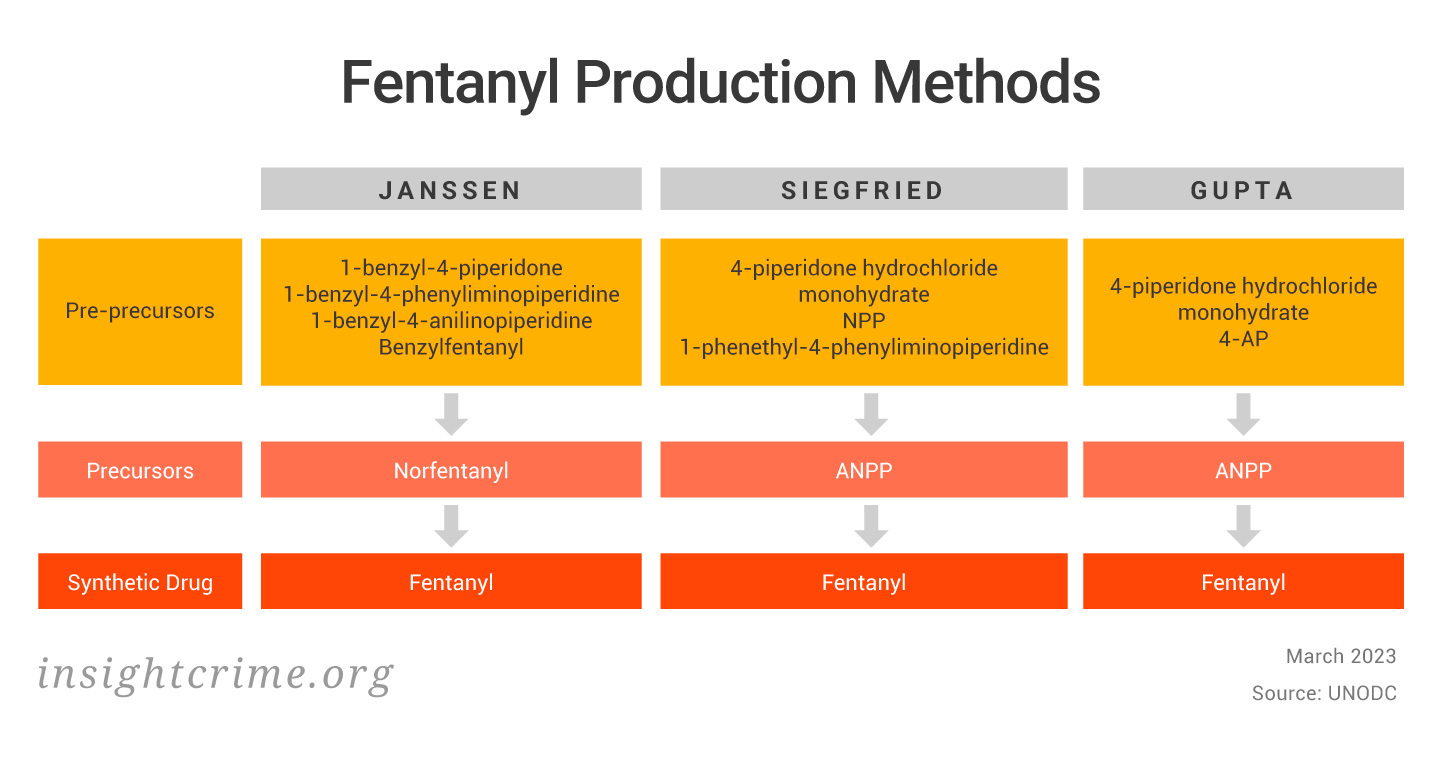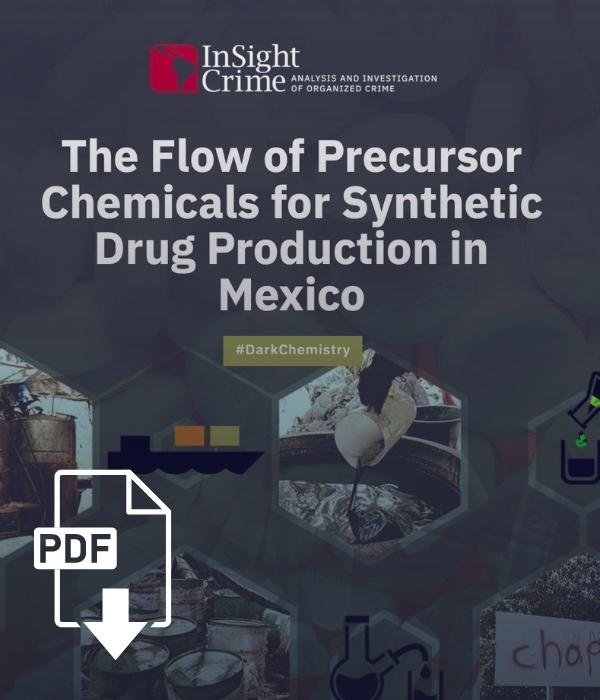The process of making synthetic drugs involves various steps, but it must include a key ingredient called a precursor. For methamphetamine, these precursors are 1-phenyl-2-propanone (P2P) and methylamine; for fentanyl, these are 4-anilino-N-phenethylpiperidine (ANPP) and norfentanyl.
Since P2P, methylamine, ANPP, and norfentanyl are heavily regulated, synthetic drug producers have turned to pre-precursors, which are at least one step behind in the production chain from P2P, methylamine, ANPP, or norfentanyl. In other words, pre-precursors are themselves precursors used to manufacture any of the four chemicals mentioned above.
These pre-precursors come in two forms: designer precursors and dual-use precursors. Designer precursors are made specifically to produce illicit synthetic drugs. These have no known legal purposes and are created to avoid international controls. Hence, they are not heavily regulated — often because authorities have not yet detected these or have not gone through the process of regulating them — and can thus be produced and moved with greater ease between countries. Dual-use precursors have more than one use — commercial, academic, medical, etc. — and can also mostly move more freely between nations, as long as the trade complies with international regulations.
Some pre-precursors, however, are subject to harsher controls and are therefore more difficult to obtain. An example of this is N-Phenethyl-4-piperidinone (NPP), a chemical that is used to develop ANPP. This substance’s only legal use is for the licit production of fentanyl, and its commercialization is thus tightly controlled across the world. Phenylacetic acid is another example. It is a chemical used to produce P2P but is also employed in the cosmetic and pharmaceutical industries.
SEE ALSO: Endless Chemical Innovations Are Killing Thousands of Americans
Other chemicals are also essential for the development of methamphetamine and fentanyl. These include binders, dyes, solvents, catalysts, and reagents. Binders connect the chemical compounds permanently or partially. Dyes add or modify the color of the products. Solvents dissolve or disperse chemicals. Reagents are substances that mediate a chemical reaction, and catalysts are required to accelerate the reaction. None of these are part of the final product but are needed for the manufacturing of the precursors and/or pre-precursors.
In general terms, we see the process of obtaining chemicals and synthesizing them into illicit synthetic drugs as a pyramid like the one depicted in the graphic below. At the base are essential chemical substances, which are widely available and traded and, thus, the most difficult to regulate. Moving up the pyramid, these chemicals become more important to the criminal organizations, and are both harder to find and more important to regulate.

But the pyramid also illustrates the paradox of this illicit trade. For Mexican criminal organizations to obtain synthetic drugs, they can subvert regulations by going down a level on the pyramid, drawing from the huge pool of less-regulated chemicals. If governments police those chemicals too much, they risk inhibiting commercial activity and trade. The potential balance between these imperatives has made it difficult for authorities to address precursors.
How to Make Methamphetamine
There are at least a hundred ways to produce methamphetamine, according to InSight Crime interviews with Mexican authorities. The two most-used methods are derived from synthesizing ephedrine, pseudoephedrine, or phenylpropanolamine (also called norephedrine); and the method derived from 1-phenyl-2-propanone (also called P2P). For years, the first method was the dominant means through which Mexico-based producers made methamphetamine. But in 2008, Mexico established firmer controls over the import and use of ephedrine, pseudoephedrine, and phenylpropanolamine.
Since then, traffickers have migrated to the P2P-based method. Although this precursor is not easy to handle and requires some expertise to synthesize and convert into high-quality methamphetamine, according to interviews with Mexican officials, it has become the dominant method of illegal methamphetamine production in Mexico.

One of the most popular synthesis routes in the production of methamphetamine using P2P is called reductive amination. This recipe requires P2P and another precursor known as methylamine. In 2019, 99.2% of the methamphetamine samples analyzed by the United States Drug Enforcement Administration (DEA) from suspected Mexican trafficking groups had used the reductive amination method. Because P2P and methylamine are highly regulated, criminal groups have turned to pre-precursors to synthesize both substances. The P2P synthesis can be reached through various chemical substances, many of which have legal uses in the chemical, pharmaceutical, and agricultural industries, among others.

No matter the method, Mexican traffickers are known to produce extremely high-purity methamphetamine. The most recent samples analyzed and published by the DEA’s Methamphetamine Profiling Program yielded a purity of 97.2% and a potency of 97.5%. Some Mexican producers seem to have improved the quality of methamphetamine produced through P2P by introducing the use of a variety of chemicals, illustrating the dynamism and ingenuity in the field.
Even so, there is still a range of products on the market. According to two synthetic drug traffickers interviewed in the state of Michoacán, some producers choose quantity over quality by mixing in sodium hydroxide, gasoline, and other substances to increase volume. The product, according to the producers, is sold to one of the myriad criminal organizations operating in that region, then transported principally to the United States — part of a multi-billion dollar flood of cheap methamphetamine that has helped lower the wholesale price in California from $14,000 per pound in 2005 to as low as $1,400 today, according to two InSight Crime interviews with counterdrug agents in California. Experts interviewed for this investigation said the evolution of methamphetamine production in Mexico is a sign of things to come as it relates to fentanyl production in the country.
How to Make Fentanyl
There are three popular methods for synthesizing fentanyl: the Janssen, the Siegfried, and the Gupta. The Janssen method was the first known method for the synthesis of fentanyl. It was derived from Paul Janssen’s work, published in the 1960s. According to the United Nations Office on Drugs and Crime (UNODC), this method is the most complex of all the current methods employed and requires the most time to execute. It may also be the most dangerous. Ninety-four percent of the fentanyl samples analyzed by the DEA in 2018, and 64% of the samples analyzed in 2019, were synthesized using the Janssen method. This method requires pre-precursors such as 1-benzyl-4- piperidone, 1-benzyl-4-phenyliminopiperidine, 1-benzyl-4-anilinopiperidine, and benzylfentanyl, for the synthesis of norfentanyl, its main precursor. Norfentanyl, benzylfentanyl and benzyl-4-piperidone are not scheduled but are currently regulated by the Mexican government.
SEE ALSO: From Deception to Demand: US Fentanyl Users Now Want Fentanyl
The second method, the Siegfried method, dominated the illicit fentanyl market for years. The Siegfried method obtains fentanyl through synthesizing N-phenethyl-4-piperidinone (NPP) to arrive at 4-anilino-N-phenethylpiperidine (ANPP), one of the main precursors of fentanyl. The recipe was published in the 1990s on the Internet, and, around 2010, became the leading method to illegally produce fentanyl. According to its recipe, this method can produce 99.5% pure fentanyl. In 2017, the UN scheduled NPP and ANPP, which appears to have pushed criminal groups towards other methods. However, Mexican authorities have seized NPP in recent years, indicating the continued use of this method.

The third method, Gupta, is currently considered the most widely used to produce illicit fentanyl, according to samples analyzed by the DEA’s Fentanyl Profiling Program. This method was patented in 2009 by Pradeep Kumar Gupta, Laxmi Manral, Kumaran Ganesan, Ramesh Chandra Malhotra, and Krishna Murthy Sekhar, members of the Defense Research and Development Organization from India’s Ministry of Defense.
The Gupta method requires 4-anilinopiperidine (4-AP), which produces ANPP. What’s more, unlike the Siegfried method — which requires three previous steps to produce ANPP — Gupta obtains ANPP in two steps in one single vessel, leading to its nickname, the “one-pot method.” These shortcuts — and the inadvertent marketing via its catchy nickname — may have made the method more attractive for illegal production. Moreover, through the Gupta method, illicit producers can produce over 650,000 different types of fentanyl analogues.
As outlined in other articles of this series, the Gupta method is particularly relevant in Mexico where rudimentary chemists, often referred to simply as “cooks,” appear to be converting pre-precursors like 4-AP into ANPP, before using that to make fentanyl; or simply getting their hands on ANPP and converting that into fentanyl.
There are other methods, of course, and illegal groups adapt as laws change and availability changes. The Valdez, Leif, and Mayer (2014) method, for example, combines intermediate steps from different methods to produce NPP and ANPP. Usually, illegal fentanyl producers move between different methods and intermediary steps to produce fentanyl. This allows them to avoid certain precursor or pre-precursor chemicals that are difficult to access because of regulations or to optimize processes to obtain more of the drug. Even the method the cooks in Mexico are using to make fentanyl may be a poor facsimile of the Gupta or some variation thereof.
*Note: InSight Crime does not condone or promote the development of these drugs and is not providing specific formulas but rather the main chemicals needed for synthesis as a means of illustrating the complexity of controlling the trade of these chemicals. Much of this information is also available on the Clearnet and from international drug-control institutions, such as the 2022 International Narcotics Control Board report.


